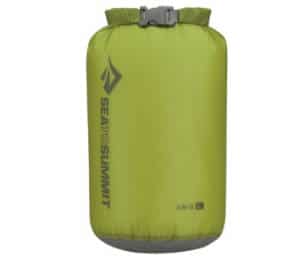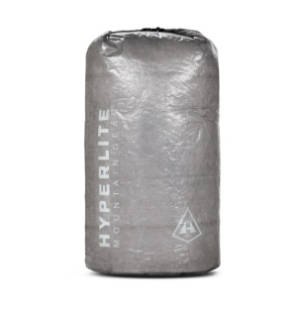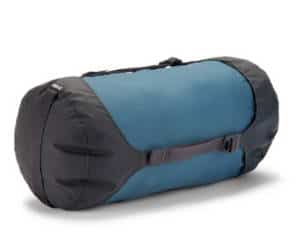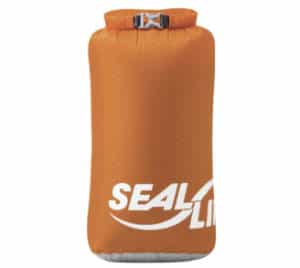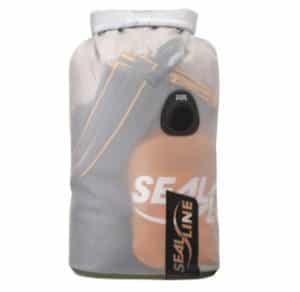Stuff sacks are an essential piece of backpacking and camping gear that keep sleeping bags or quilts dry, organized, and compressed. However most of the manufacturer’s stuff sacks that come with sleeping bags or quilts are designed for uncompressed storage, not field use, and it’s often necessary to purchase a separate compression sack, roll-top stuff sack, or waterproof dry sack to serve these functions.
Here are the 10 best sleeping bag stuff sacks that we recommend and rely on to protect our backpacking quilts and sleeping bags. Why the variety? Different types of sleeping bags and quilts require different size sleeping bag stuff sacks. Be sure to read our sleeping bag stuff sack selection guide below.
1. Sea to Summit Ultra-Sil Drysack
https://amzn.to/3Jrrpan
2. Sea to Summit Ultra-Sil Compression Sack
3. Sea to Summit Evac Compression Dry Bag
4. Hyperlite Mountain Gear Roll-Top Stuff Sacks
5. REI Lightweight Compression Sack
6. Outdoor Products 3-Pack All Purpose Dry Sacks
7. Sealine Blocker Dry Sack
8. Hyperlight Mountain Gear Packing Pods
9. Six Moon Designs Packing Pods
10. SealLine Discovery View Dry Bag
Sleeping Bag Stuff Sack Guide
There are all kinds of tradeoffs to be made when choosing a sleeping bag stuff sack, which we detail below.
Types of Stuff Sacks
There are basically three kinds of stuff sacks appropriate for packing sleeping bags and backpacking quilts.
- Roll-top Dry Bags
- Compression Sacks
- Purgeable Stuff Sacks, either roll-top or compression
Roll-top Dry Bags are best for lightweight sleeping bags and quilts, usually, down-insulated, that are easy to compress with little effort. A roll-top closure is more durable than a zipper and the rolling process makes it very difficult for water to pass through the top of the stuff sack.
Compression Sacks are best for larger and bigger sleeping bags and quilts, such as winter sleeping bags or sleeping bags and quilts insulated with synthetic insulation which is harder to compress. Compression sacks have buckles and webbing straps that help you make the size of the stuff sack smaller, so it takes up less room in your backpack. Compression sacks with four webbing straps are easier to use and compress better than those with three webbing straps.
Purgeable Stuff Sacks have purge values or breathable fabric panels that vent air from the stuff sack when it is compressed, but don’t let it back in. They can be roll-tops or compression sacks. They’re useful when you feed to get the maximum compression possible by forcing all of the air out of your sleeping bag and preventing its return.
How to Size a Sleeping Bag Stuff Sack
What is the best size stuff sack for a sleeping bag or quilt? Sleeping bags and quilts that have synthetic insulation usually require large stuff sacks than those insulated with down, which compresses more easily. The volumes required for quilts will be at the lower end of the range because they don’t come with a hood and take up slightly less volume than sleeping bags.
| Insulation Type | Temperature Rating | Recommended Stuff Sack Volume |
|---|---|---|
| Down | 40 F / 4 C | 6-8 liters |
| Down | 20 F / -7 C | 8-12 liters |
| Down | 0 F / -18 C | 14-20 liters |
| Down | 20 Below F / 29 Below C | 20-30 liters |
| Synthetic | 40 F / 4 C | 9-13 liters |
| Synthetic | 20 F / -7 C | 16-20 liters |
| Synthetic | 0 F / -18 C | 25-35 liters |
In most cases, you’ll want to get a sleeping bag stuff sack that is just large enough to close easily, but not capture too much excess air, which will increase the packing space it requires. If the stuff sack has a roll-top closure, you’ll also want enough slack fabric on top so you can roll the stuff sack three times to close it. This is the ideal number of turns to prevent water from leaking through the top opening.
Water Resistance Vs Waterproofness
Most backpacking and camping stuff sacks are water-resistant and not fully waterproof for immersion underwater. If they have zippers or seam-taped seams, water can leak through them. They will still protect your sleeping bag from moisture, but your best bet is to pack them inside a backpack that is lined with a plastic bag or covered with a rain cover to prevent rain from reaching them. Fully waterproof stuff sacks intended for rafting, kayaking, or canoeing have welded seams that don’t leak when immersed and are usually made with tougher materials.
Color Coding
Multi-colored stuff sacks can make it much easier to organize your gear and find it inside a backpack. Transparent fabrics or panels can serve a similar function, allowing you to see the contents so you know what they contain.
Stuff Sack Weight
While stuff sacks can make it much easier to organize and locate your gear in a backpack, they can add significant extra weight to your gear list if you go overboard with them. Be sure to compare the weights of different options. For example, Dyneema DCF stuff sacks vs those made with PU-coated nylon. In some instances, there’s less of a weight difference than you might expect, but there is a huge price difference!
Durability vs Weight
There’s usually a tradeoff between durability and weight when it comes to stuff sacks that’s worth considering when selecting a sleeping bag stuff sack or dry bag. If you plan to store your sleeping bag inside another bag like a backpack, there’s often less of a need for a heavy-duty, abrasion-resistant, or waterproof sleeping bag stuff sack when a lighter-weight one will function just as well.
Check Out All of SectionHiker’s Gear Guides!
SectionHiker is reader-supported. We only make money if you purchase a product through our affiliate links. Help us continue to test and write unsponsored and independent gear reviews, beginner FAQs, and free hiking guides.

